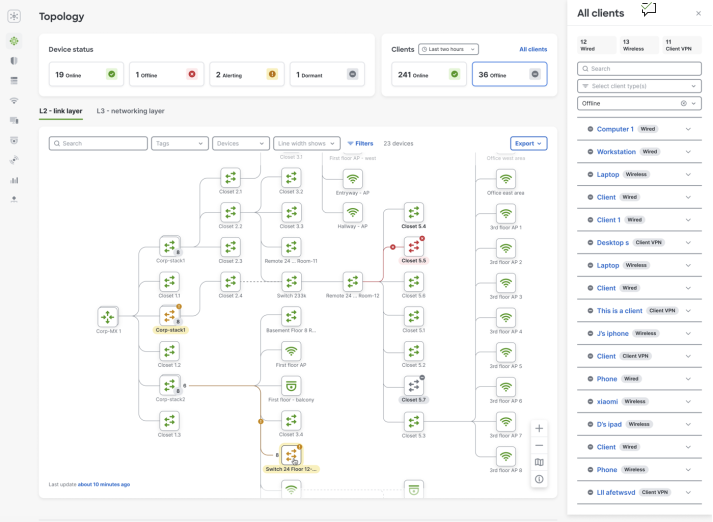From Wi-Fi 6E (and the upcoming Wi-Fi 7 technologies) to smart cameras, IoT devices are expected to grow by 50% by 2027. As organizations leverage more of these intelligent, data-generating machines to boost employee productivity and user experience, they may want to consider the impact on the network.
The associated data influx of additional IoT devices could lead to network congestion and slow response times, affecting the performance and reliability of both the network and the IoT devices it supports. Moreover, IoT devices can be susceptible to cyberattacks. Is your network infrastructure ready to handle the expected IoT growth?
Imagine investing in interactive whiteboards to enhance employee collaborations, only to experience network congestion causing delays in sharing and saving content. This would lead to frustrated employees and upset clients.
Realizing IoT investment starts with a secure backbone
We recently expanded our Cisco Catalyst 9300-M switching portfolio with 15 new models designed to meet your most demanding use cases. It enables you to deliver a flexible and secure end-to-end network at scale while managing it with ease and confidence. Here are some features designed to unlock new use cases while lowering deployment and operational costs:
- Secure networking across sites: extension of Adaptive Policy across all new platforms and capable of up to 1T physical stacking and stacking flexibility across models.
- Smart, sustainable spaces: 90W Universal Power Over Ethernet (UPOE+), 1,900W power supply option, and StackPower.
- Digital experiences and assurance: high-density mGig and fiber options and 25G/100G uplinks.
For more detailed information, please refer to the datasheet. Tune in to our latest Cisco Champion Radio episode and learn how these latest Catalyst 9300-M switches can help our customers solve the most challenging IT and security needs at scale.
Power more distributed, smarter, and sustainable spaces with UPOE+
The expansive corporate campuses of yesterday have given way to a new age of decentralized offices and hybrid work structures. A recent Cisco survey underlines this change, showing that 98% of meetings now involve at least one remote participant.
The new Catalyst 9300X-M 90W UPOE+ switching powerhouses can connect more power-hungry PoE devices securely to ensure application operations and frictionless user experiences, such as smart lighting systems, conferencing system, and smart cameras. The best part? All your Meraki devices across distributed locations can be managed centrally on the Meraki dashboard, unlocking dynamic topology and rich telemetry, enabling your team with a deeper understanding and control of the entire network for faster mean time to resolution and effective security management.
When converging network and power management, it reduces deployment and simplifies ongoing operations. PoE management on Meraki dashboard can also help you achieve sustainability goals.
For example, the Wrexham County Borough Council in the United Kingdom used Meraki sensors and Cisco Meraki switch port schedules to reimagine its IT infrastructure to reduce cost and carbon emissions across 70 schools. The council has been able to make significant energy savings of 10 metric tons of carbon and roughly $28,000 in electricity savings per year across its 70 schools.
Connect everyone and everything securely with streamlined security
The traditional VLAN-based security policy approach is insufficient, introducing skill gaps and challenges for your IT and security teams to maintain.
Adaptive Policy enables secure access to network resources by dynamically segmenting the network based on user identity and context. This approach reduces SecOps efforts and costs by eliminating the need for manual management of thousands of access control lists (ACLs) and re-architecting the network infrastructure when deploying policy changes.
It strengthens security by automatically applying appropriate policies to the correct users and devices. Back to the earlier example, it will ensure employees can access the interactive whiteboard without delays, while unauthorized devices such as smart cameras will not have access to business applications.
Simplify network operations with an agile, flexible platform
In a distributed IT landscape, Cisco Meraki provides a centralized end-to-end management experience, from wired and wireless, to security, to IoT. This comprehensive approach helps your team deliver secure network management at scale without a steep learning curve. Your network team can make configuration changes in one place and push to selected locations, eliminating manual processes and potential human errors.
Real-time application visibility and rich telemetry provide your network teams with proactive insights to optimize the network, ensuring a seamless employee experience. Furthermore, firmware updates are made effortless with Meraki. Simply schedule and stage them from the cloud, improving productivity for your team.
Resilient, secure networks start here
The Catalyst 9300-M switching portfolio, along with the scalable Adaptive Policy, can help you navigate this new influx of data and network requirements. For more information, please explore our page or contact our sales team.
The post Is Your Network Infrastructure Ready for More IoT Devices? appeared first on The Meraki Blog.









